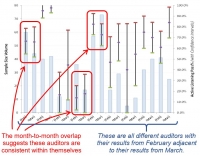 Many people (including experts) will state that the purpose of Lean is to reduce waste and the purpose of Six Sigma is to reduce variation. But I think that's like saying the purpose of a hammer is to hit a nail. While that is technically true, the real purpose of the hammer is to accomplish the purpose of the carpenter, which could be to build a house. I think this confuses the "what" with the "why" where the "what" is hitting the nail, which in and of itself is meaningless without the "why", i.e., building the house.
Many people (including experts) will state that the purpose of Lean is to reduce waste and the purpose of Six Sigma is to reduce variation. But I think that's like saying the purpose of a hammer is to hit a nail. While that is technically true, the real purpose of the hammer is to accomplish the purpose of the carpenter, which could be to build a house. I think this confuses the "what" with the "why" where the "what" is hitting the nail, which in and of itself is meaningless without the "why", i.e., building the house.
In the same way, reducing waste for Lean and variation for Six Sigma are merely the "what". They define the technical purpose without correlating them to the ideal purpose of the one using them. They are merely tools which, like a hammer to a skilled carpenter, are only as effective as the one using those tools. Until we make that clear distinction, we'll never fully succeed in accomplishing the "why".
What is the "Why" for Lean Six Sigma?
The ultimate purpose for Lean Six Sigma is to make the business successful primarily by improving its financial performance. Yes, it primarily comes down to money. Every organization, including non-profit organizations, must have money to survive. It doesn't matter how altruistic an organization's products, services or goals are, how satisfied their customers are, nor how beloved they are in the marketplace (all other Level 1 CTQs in the CTQ Drilldown) - without a positive financial value (e.g., cash, assets, etc.) the organization will not be able to survive very long.
So how does the "what" of Lean Six Sigma fit into this? By reducing waste in a process, Lean can help a business be more efficient which is typically measured by improved flow and productivity (for people, machines, or equipment). This kind of improvement can often be realized through reduced payroll which helps to improve the financial performance of the business.
Likewise, by reducing variation in the output from a process, Six Sigma can help a business be more effective which is typically measured by improved quality and accuracy to meet a customer's requirements and less product scrap or waste. These kinds of improvements can be realized through more revenue, less returns, and reduced cost from scrapped materials which help to improve the financial performance of the business.
Lean Six Sigma will fail if we don't focus on the "why"
I believe every Lean Six Sigma effort must be focused on improving the Level 1 CTQs of the business, especially financial performance. If you cannot tie a Lean Six Sigma project to a financial improvement in the business, then I believe that project is a failure.
That's right. It's a failure. Otherwise why would we spend our own time and resources to work a project that doesn't yield any measurable improvement back to the organization? Was it just for fun? Was it just for trying to grow the personal or political control for ourselves or our business leaders? If so, then please do the rest of us a favor and don't apply the "Lean Six Sigma" label to it; it's counter-productive to it's true intent and only gives a bad name to it and those who practice it as such.





















